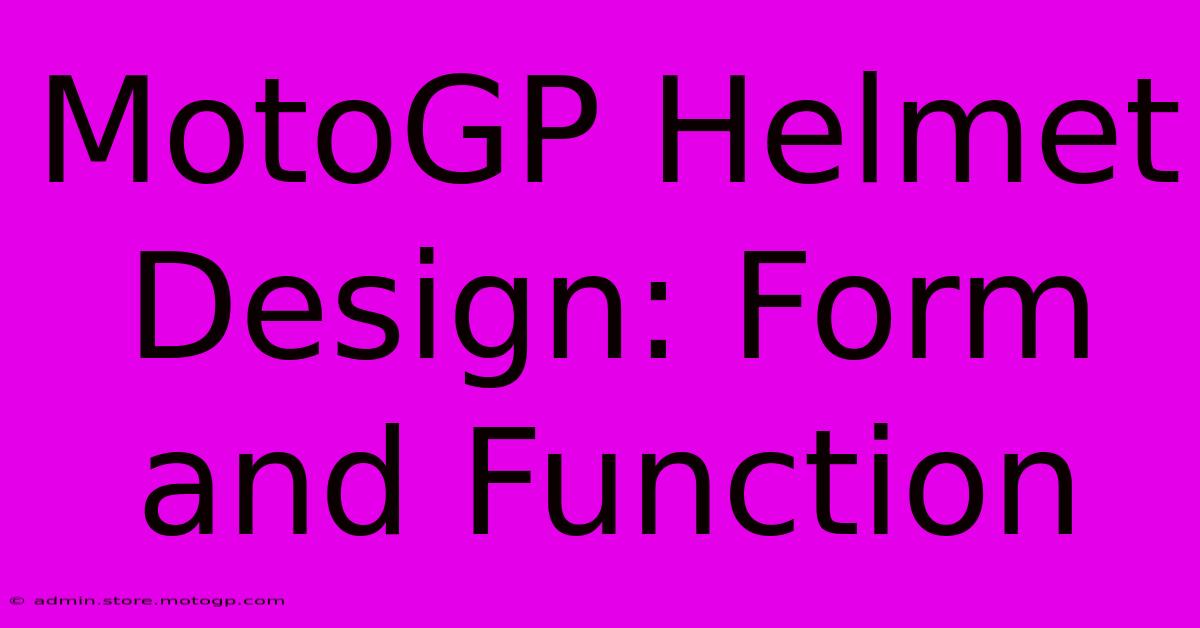MotoGP Helmet Design: Form And Function

Table of Contents
MotoGP Helmet Design: Form and Function
MotoGP racing pushes the boundaries of speed and skill. Behind the visor of every rider lies a crucial piece of safety equipment – the helmet. It's not just a hard shell; it's a meticulously engineered marvel of form and function, a testament to technological advancement designed to protect the rider at incredibly high speeds. This article delves into the critical design aspects that make these helmets so essential to the sport.
The Crucial Role of Safety
The primary function of a MotoGP helmet is undeniably safety. These helmets are far more than just protective headgear; they are sophisticated systems designed to absorb and distribute impact forces from crashes, which can reach devastating levels at MotoGP speeds. The design incorporates:
-
Multi-Composite Shell Construction: Instead of a single material, MotoGP helmets use a blend of materials like carbon fiber, aramid fiber (Kevlar), and fiberglass. This layered construction maximizes strength-to-weight ratio, offering superior impact protection without excessive weight that could hinder rider performance.
-
Advanced Liner Technology: The inner liner is crucial for shock absorption. Many manufacturers employ EPS (Expanded Polystyrene) liners, sometimes with multiple densities to better manage varying impact forces. These liners are specifically engineered to deform upon impact, reducing the transfer of energy to the rider's head.
-
Chin Bar and Face Protection: The chin bar is designed to protect the rider's jaw and face from impacts. Many modern designs incorporate advanced aerodynamics to minimize lift at high speeds, enhancing stability. Some helmets also include integrated face shields offering additional protection.
-
Emergency Release System: Time is critical in emergency situations. Many MotoGP helmets now feature cheek pad emergency release systems, allowing medical personnel to quickly and safely remove the helmet without further injuring the rider's neck.
Beyond Safety: Aerodynamics and Comfort
While safety is paramount, MotoGP helmet design extends beyond mere protection. Performance is key, and this translates into two critical areas: aerodynamics and rider comfort.
Aerodynamic Considerations
-
Reduced Drag: At the speeds reached in MotoGP, even a slight reduction in drag can make a significant difference. Helmet designers utilize Computational Fluid Dynamics (CFD) to optimize the helmet's shape, minimizing wind resistance and improving rider stability.
-
Minimized Lift: High speeds create lift, potentially destabilizing the rider's head. Helmet design focuses on minimizing this lift, ensuring the rider maintains control and precision at all times. Spoiler designs and strategically placed vents help achieve this.
-
Ventilation: Maintaining rider comfort and preventing overheating is crucial. Sophisticated ventilation systems, including strategically placed vents and internal channels, keep cool air flowing over the rider's head while expelling hot air. This is especially important during the intense physical exertion of a race.
Rider Comfort and Customization
-
Weight and Balance: Even a slight difference in weight can impact rider fatigue and performance over the course of a race. Minimizing weight without compromising safety is a crucial design consideration. Weight distribution also plays a role, with helmets designed for a balanced feel on the rider's head.
-
Fit and Sizing: A properly fitting helmet is crucial for both safety and comfort. MotoGP helmets often offer a customized fit, with adjustable padding and different shell sizes to perfectly accommodate the rider's head shape.
-
Visor Technology: The visor is another critical element. Modern visors utilize anti-scratch and anti-fog coatings for optimal clarity in any conditions, and some offer built-in tear-offs for clear vision during wet or dirty racing.
The Future of MotoGP Helmet Design
The pursuit of enhanced safety and performance in MotoGP helmet design is a continuous process. Advancements in materials science, aerodynamics, and impact protection technologies promise even more sophisticated helmets in the future. We can anticipate even lighter, more aerodynamic designs with advanced safety features, pushing the boundaries of protection and rider performance.
In conclusion, MotoGP helmet design is a complex interplay of engineering, safety, and performance. These helmets are not simply protective shells; they represent a pinnacle of technological advancement, critical to the safety and success of the world's best motorcycle racers. The continuous evolution of these designs underscores the relentless pursuit of improving rider safety and maximizing on-track performance in the thrilling world of MotoGP.

Thank you for visiting our website wich cover about MotoGP Helmet Design: Form And Function. We hope the information provided has been useful to you. Feel free to contact us if you have any questions or need further assistance. See you next time and dont miss to bookmark.
Featured Posts
-
The Million Dollar Question Moto Gp Bike Prices
Feb 19, 2025
-
Austin Gp Sprint Race Pushing The Limits Of Speed
Feb 19, 2025
-
Moto Gp Desmosedici Experience The Legacy
Feb 19, 2025
-
Explore The Majesty Of The Americas The Queen Circuit
Feb 19, 2025
-
Cota Parking Lot T The Smartest Way To Park At Cota
Feb 19, 2025
